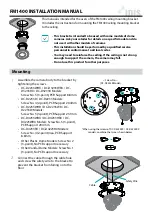
3 Commissioning Process
Airbridge BTS3606E&3606AE
System Commissioning Guide
3-4
Huawei Technologies Proprietary
Issue 02 (2006-10-10)
z
For the descriptions of board indicators or module indicators, see the
Airbridge BTS3606E CDMA
Base Station Hardware Reference or the Airbridge BTS3606AE CDMA Base Station Hardware
Reference.
z
For the detailed information of BTS alarms, see the online help and the
Airbridge
BTS3606E&3606AE CDMA Base Station Site Maintenance Guide
or the detailed alarm description
of the alarm management system.
z
For the troubleshooting related to BTS startup, see the
Airbridge BTS3606E&3606AE CDMA Base
Station Site Maintenance Guide
.
3.2.2 Description of the BTS Startup Process
This section details the steps shown in Figure 3-2.
Board Initialization
After the BTS is powered on, the BOOT software of each board transfers the board software
from the Flash memory to the RAM. After the board self-test and initialization, the
communication link between the boards is set up.
If the board initialization fails, the board resets.
Table 3-1 describes the symptom of board initialization.
Table 3-1
Symptom of board initialization
Observation
Method
Description
Through indicators
of the BTS
During the power-on and initialization process of the BCKM and
the BCIM, the RUN indicator flashes fast at 4 Hz.
Before the operation and maintenance link (OML) is set up, the
ACT indicator on the BCKM flashes fast at 4 Hz.
The frequency at which the ALM indicator flashes varies with the
alarm level.
On the service
maintenance system
The BTS is in the link interruption state.
Setting Up the OML
After the self-test, the baseband boards set up the OML with the BSC. Setting up the OML
from the BTS to the BSC is the prerequisite for configuring the BTS at the far end.
The physical bearer between the BTS and the BSC can be E1/T1 or FE. These bears can be
used to transmit ATM cells and IP packets.
The BTS supports the following three modes for setting up OMLs:
z
Setting up the OML in ATM over E1/T1 mode
z
Setting up the OML in IP over E1/T1 mode
z
Setting up the OML in IP over FE mode
















































